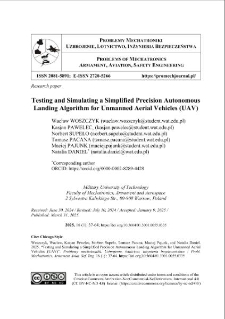Nasza Biblioteka Cyfrowa udostępnia 1 868 obiektów cyfrowych
Obiekt
Tytuł: Testing and Simulating a Simplified Precision Autonomous Landing Algorithm for Unmanned Aerial Vehicles (UAV) ; Testing and Simulating a Simplified Precision Autonomous Landing Algorithm for Unmanned Aerial Vehicles (UAV)
Tytuł odmienny:
Testy i symulacje uproszczonego algorytmu precyzyjnego autonomicznego lądowania bezzałogowego statku powietrznego (BSP) ; Testy i symulacje uproszczonego algorytmu precyzyjnego autonomicznego lądowania bezzałogowego statku powietrznego (BSP)
Współtwórca:
Kasjan PAWELEC , Norbert SUPEŁO, Tomasz PACANA, Maciej PAJUNK, Natalia DANIEL ; Kasjan PAWELEC , Norbert SUPEŁO, Tomasz PACANA, Maciej PAJUNK, Natalia DANIEL
Abstrakt:
Drones are capable of carrying objects of various types. However, their landing pad detection systems did not consistently perform as intended to environmental conditions, such as inclement weather or inadequate illumination. This article presents a simplified precision landing algorithm for unmanned aerial vehicles (UAV) with the objective of enhancing accuracy of the landing procedure. The proposed system relies on integrating a GPS module, an ultrasonic distance sensor and a proximity sensor. The GPS is responsible for navigating the drone to the designated Target location, the ultrasonic sensor assists in decreasing the drone’s altitude, and the proximity sensor ensures an accurate detection of the landing pad. The UAV is required to execute landings in open environments, where fluctuating environmental conditions and mobile landing pads represent principal challenges. Therefore, the model takes into account has such difficulties as reduced stability, caused by wind or non-permanent placement of the landing pad over time. The study included simulations performed in the Python environment, which allowed to test the algorithm’s effectiveness in different scenarios, such as variable weather conditions and landing pads moving at different speeds. Simulation results show that the simplified model allows to limit the landing error to a few centimeters, which proves its effectiveness during a safe UAV precision landing procedure. Future testing performed by the authors will encompass the development of a dynamic algorithm, physical modifications to the UAV and a comparative of simulation results.
;
Drones are capable of carrying objects of various types. However, their landing pad detection systems did not consistently perform as intended to environmental conditions, such as inclement weather or inadequate illumination. This article presents a simplified precision landing algorithm for unmanned aerial vehicles (UAV) with the objective of enhancing accuracy of the landing procedure. The proposed system relies on integrating a GPS module, an ultrasonic distance sensor and a proximity sensor. The GPS is responsible for navigating the drone to the designated Target location, the ultrasonic sensor assists in decreasing the drone’s altitude, and the proximity sensor ensures an accurate detection of the landing pad. The UAV is required to execute landings in open environments, where fluctuating environmental conditions and mobile landing pads represent principal challenges. Therefore, the model takes into account has such difficulties as reduced stability, caused by wind or non-permanent placement of the landing pad over time. The study included simulations performed in the Python environment, which allowed to test the algorithm’s effectiveness in different scenarios, such as variable weather conditions and landing pads moving at different speeds. Simulation results show that the simplified model allows to limit the landing error to a few centimeters, which proves its effectiveness during a safe UAV precision landing procedure. Future testing performed by the authors will encompass the development of a dynamic algorithm, physical modifications to the UAV and a comparative of simulation results.
Miejsce wydania:
Warszawa
;
Warszawa
Wydawca:
Wojskowa Akademia Techniczna ; Wojskowa Akademia Techniczna
Data utworzenia:
Data złożenia:
Data akceptacji:
Data wydania:
Rozmiar:
Identyfikator:
oai:ribes-88.man.poznan.pl:2730
Sygnatura:
doi:10.5604/01.3001.0055.0335 ; doi:10.5604/01.3001.0055.0335
ISSN elektroniczny:
ISSN drukowany:
Język:
Licencja:
kliknij tutaj, żeby przejść ; kliknij tutaj, żeby przejść
Właściciel praw:
Wojskowa Akademia Techniczna ; Wojskowa Akademia Techniczna
Strona początkowa:
Strona końcowa:
Tom:
Czasopismo:
Słowa kluczowe:
unmanned aerial vehicle, precision landing, autonomous landing algorithm, flight simulation ; unmanned aerial vehicle, precision landing, autonomous landing algorithm, flight simulation
Kolekcje, do których przypisany jest obiekt:
Data ostatniej modyfikacji:
17 paź 2025
Data dodania obiektu:
17 paź 2025
Liczba wyświetleń treści obiektu:
0
Wszystkie dostępne wersje tego obiektu:
https://ribes-88.man.poznan.pl/publication/3071
Wyświetl opis w formacie RDF:
Wyświetl opis w formacie OAI-PMH:
| Nazwa wydania | Data |
|---|---|
| Testing and Simulating a Simplified Precision Autonomous Landing Algorithm for Unmanned Aerial Vehicles (UAV) | 17 paź 2025 |

